Level 5 Diploma: Inclusive Practice in Education and Training Report
VerifiedAdded on 2023/06/08
|9
|2769
|165
Report
AI Summary
This report delves into the multifaceted aspects of inclusive practice within education and training, focusing on the chosen field of pharmacy. It begins by examining the impact of personal, social, and cultural factors, as well as cognitive, physical, and sensory abilities on learning. The report then summarizes policy and regulatory frameworks related to inclusive practice and explains their influence on organizational policies and individual practice. It outlines the author's role and responsibilities, the relationship with other professionals, and the identification of referral points to meet diverse learning needs. The report further reviews the features and benefits of an inclusive learning environment, analyzing ways to promote equality, value diversity, and foster inclusion. Strategies for effective liaison between professionals are discussed. Finally, the report assesses the effectiveness of the author's inclusive practice, identifies strengths and areas for improvement, and plans opportunities for skill enhancement, concluding with a reflection on the importance of inclusive practices.
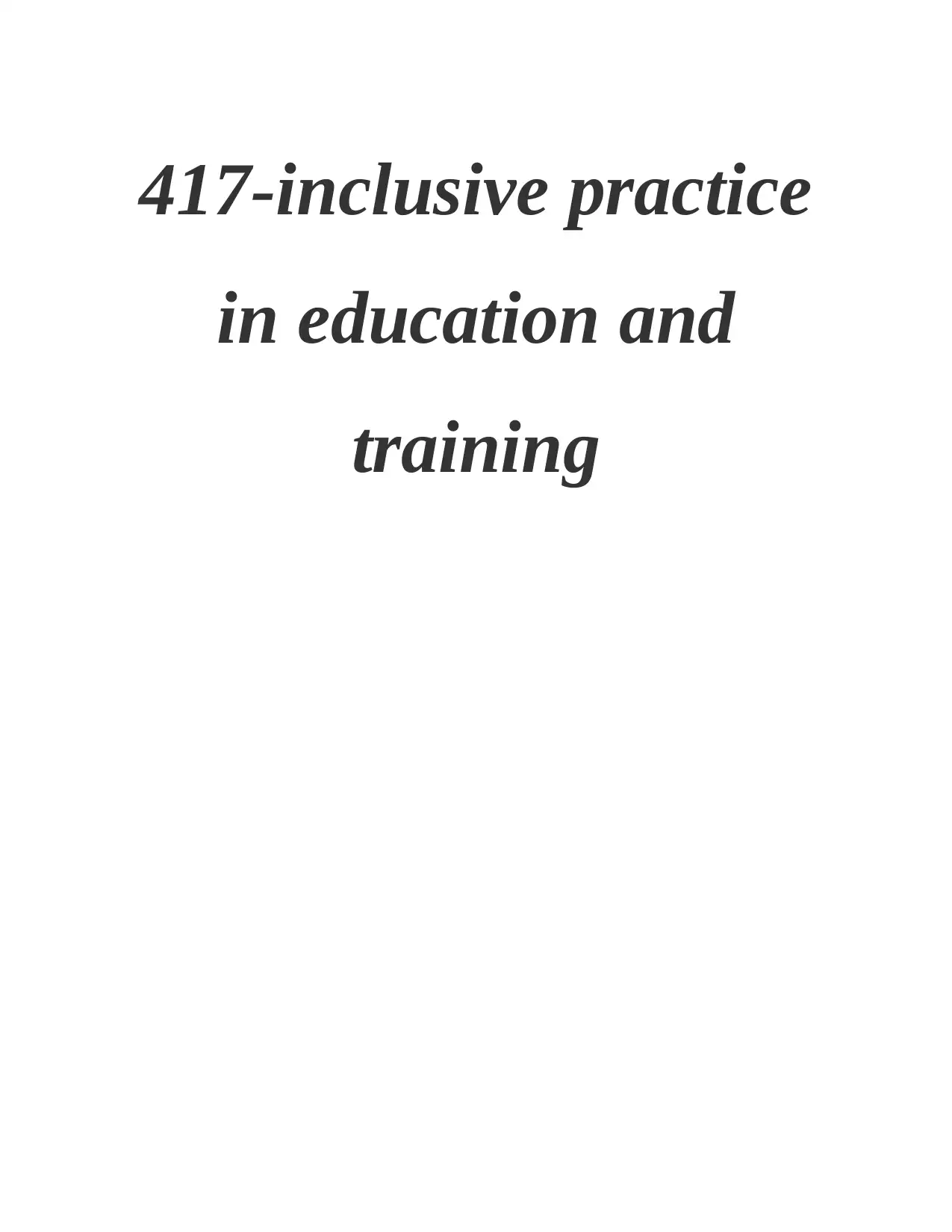
417-inclusive practice
in education and
training
in education and
training
Paraphrase This Document
Need a fresh take? Get an instant paraphrase of this document with our AI Paraphraser
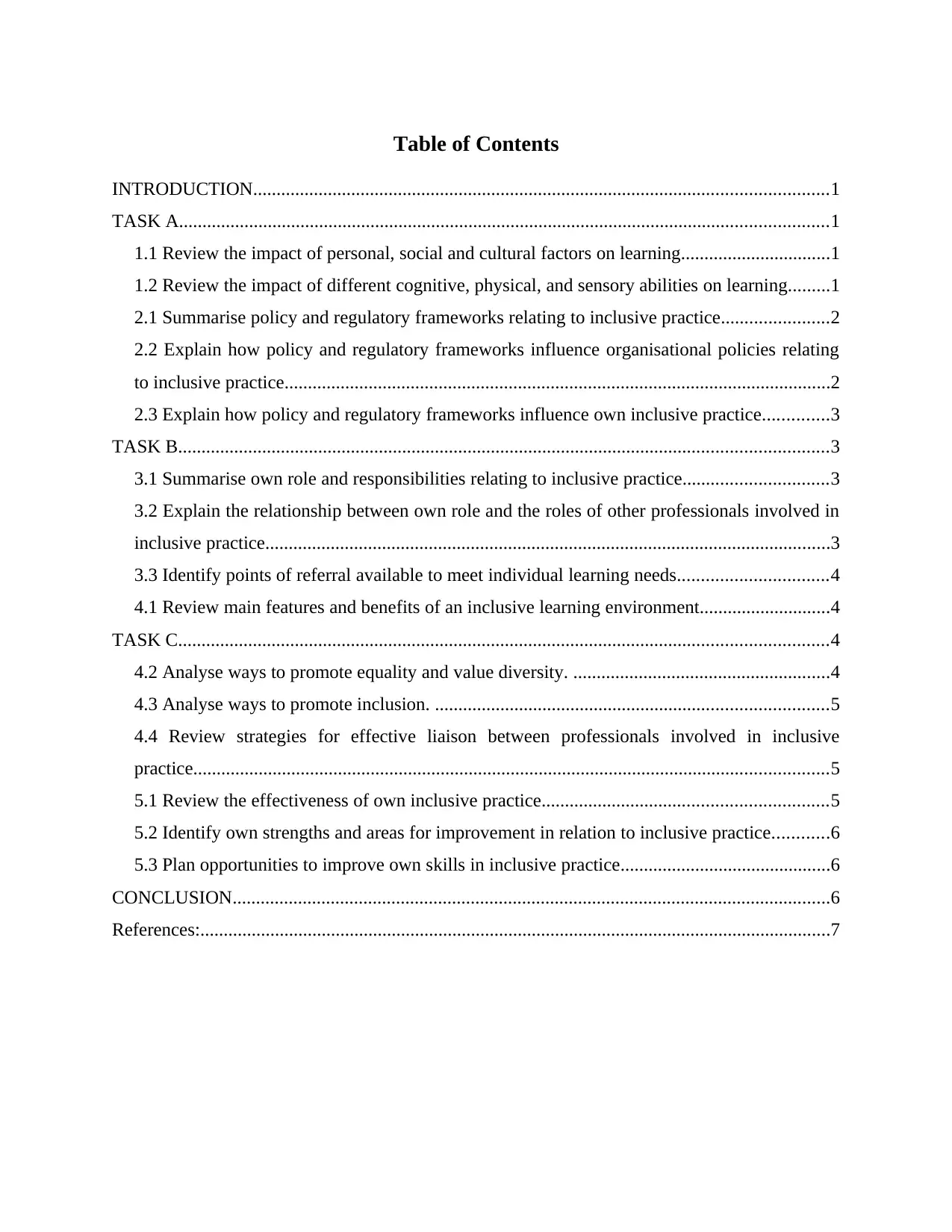
Table of Contents
INTRODUCTION...........................................................................................................................1
TASK A...........................................................................................................................................1
1.1 Review the impact of personal, social and cultural factors on learning................................1
1.2 Review the impact of different cognitive, physical, and sensory abilities on learning.........1
2.1 Summarise policy and regulatory frameworks relating to inclusive practice.......................2
2.2 Explain how policy and regulatory frameworks influence organisational policies relating
to inclusive practice.....................................................................................................................2
2.3 Explain how policy and regulatory frameworks influence own inclusive practice..............3
TASK B...........................................................................................................................................3
3.1 Summarise own role and responsibilities relating to inclusive practice...............................3
3.2 Explain the relationship between own role and the roles of other professionals involved in
inclusive practice.........................................................................................................................3
3.3 Identify points of referral available to meet individual learning needs................................4
4.1 Review main features and benefits of an inclusive learning environment............................4
TASK C...........................................................................................................................................4
4.2 Analyse ways to promote equality and value diversity. .......................................................4
4.3 Analyse ways to promote inclusion. ....................................................................................5
4.4 Review strategies for effective liaison between professionals involved in inclusive
practice........................................................................................................................................5
5.1 Review the effectiveness of own inclusive practice.............................................................5
5.2 Identify own strengths and areas for improvement in relation to inclusive practice............6
5.3 Plan opportunities to improve own skills in inclusive practice.............................................6
CONCLUSION................................................................................................................................6
References:.......................................................................................................................................7
INTRODUCTION...........................................................................................................................1
TASK A...........................................................................................................................................1
1.1 Review the impact of personal, social and cultural factors on learning................................1
1.2 Review the impact of different cognitive, physical, and sensory abilities on learning.........1
2.1 Summarise policy and regulatory frameworks relating to inclusive practice.......................2
2.2 Explain how policy and regulatory frameworks influence organisational policies relating
to inclusive practice.....................................................................................................................2
2.3 Explain how policy and regulatory frameworks influence own inclusive practice..............3
TASK B...........................................................................................................................................3
3.1 Summarise own role and responsibilities relating to inclusive practice...............................3
3.2 Explain the relationship between own role and the roles of other professionals involved in
inclusive practice.........................................................................................................................3
3.3 Identify points of referral available to meet individual learning needs................................4
4.1 Review main features and benefits of an inclusive learning environment............................4
TASK C...........................................................................................................................................4
4.2 Analyse ways to promote equality and value diversity. .......................................................4
4.3 Analyse ways to promote inclusion. ....................................................................................5
4.4 Review strategies for effective liaison between professionals involved in inclusive
practice........................................................................................................................................5
5.1 Review the effectiveness of own inclusive practice.............................................................5
5.2 Identify own strengths and areas for improvement in relation to inclusive practice............6
5.3 Plan opportunities to improve own skills in inclusive practice.............................................6
CONCLUSION................................................................................................................................6
References:.......................................................................................................................................7
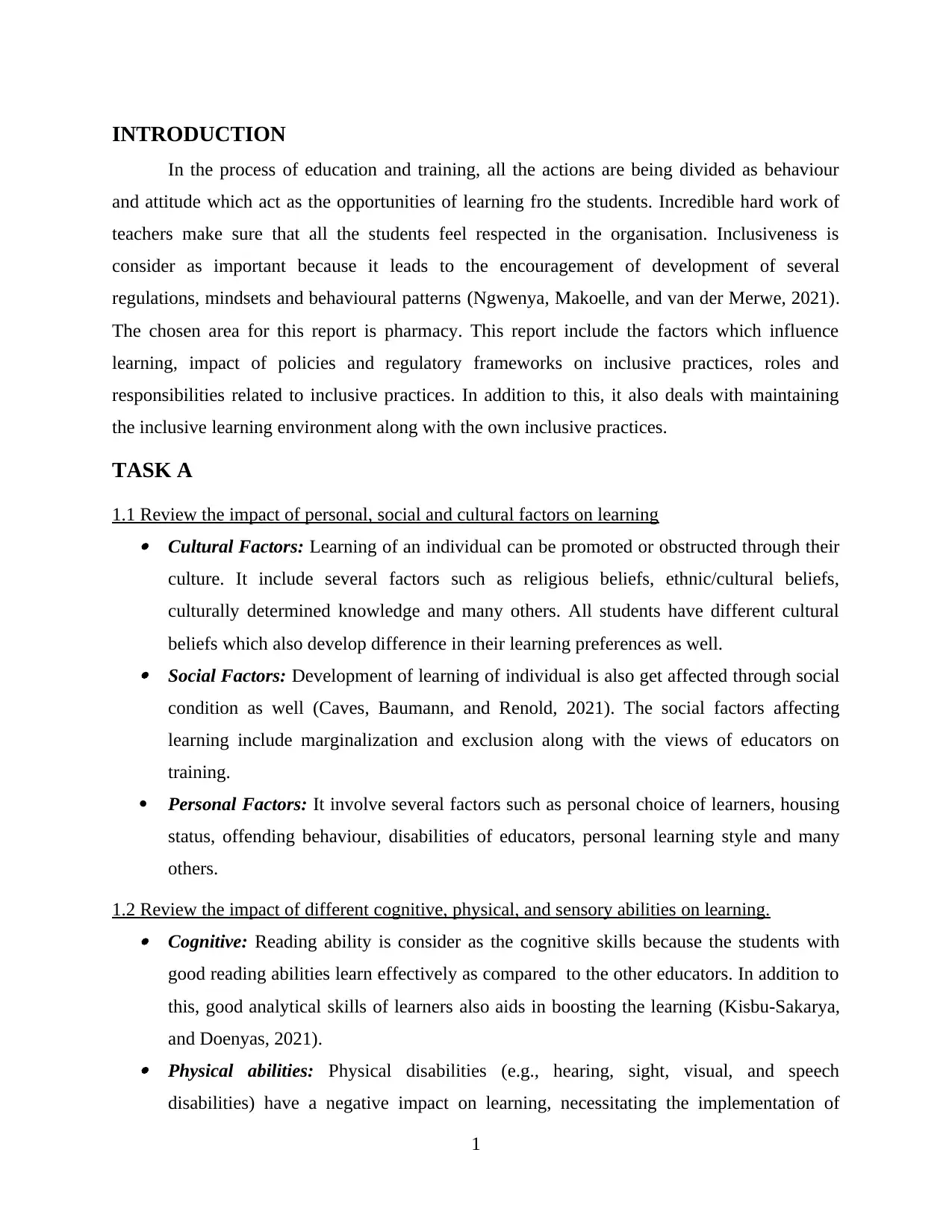
INTRODUCTION
In the process of education and training, all the actions are being divided as behaviour
and attitude which act as the opportunities of learning fro the students. Incredible hard work of
teachers make sure that all the students feel respected in the organisation. Inclusiveness is
consider as important because it leads to the encouragement of development of several
regulations, mindsets and behavioural patterns (Ngwenya, Makoelle, and van der Merwe, 2021).
The chosen area for this report is pharmacy. This report include the factors which influence
learning, impact of policies and regulatory frameworks on inclusive practices, roles and
responsibilities related to inclusive practices. In addition to this, it also deals with maintaining
the inclusive learning environment along with the own inclusive practices.
TASK A
1.1 Review the impact of personal, social and cultural factors on learning Cultural Factors: Learning of an individual can be promoted or obstructed through their
culture. It include several factors such as religious beliefs, ethnic/cultural beliefs,
culturally determined knowledge and many others. All students have different cultural
beliefs which also develop difference in their learning preferences as well. Social Factors: Development of learning of individual is also get affected through social
condition as well (Caves, Baumann, and Renold, 2021). The social factors affecting
learning include marginalization and exclusion along with the views of educators on
training.
Personal Factors: It involve several factors such as personal choice of learners, housing
status, offending behaviour, disabilities of educators, personal learning style and many
others.
1.2 Review the impact of different cognitive, physical, and sensory abilities on learning. Cognitive: Reading ability is consider as the cognitive skills because the students with
good reading abilities learn effectively as compared to the other educators. In addition to
this, good analytical skills of learners also aids in boosting the learning (Kisbu-Sakarya,
and Doenyas, 2021). Physical abilities: Physical disabilities (e.g., hearing, sight, visual, and speech
disabilities) have a negative impact on learning, necessitating the implementation of
1
In the process of education and training, all the actions are being divided as behaviour
and attitude which act as the opportunities of learning fro the students. Incredible hard work of
teachers make sure that all the students feel respected in the organisation. Inclusiveness is
consider as important because it leads to the encouragement of development of several
regulations, mindsets and behavioural patterns (Ngwenya, Makoelle, and van der Merwe, 2021).
The chosen area for this report is pharmacy. This report include the factors which influence
learning, impact of policies and regulatory frameworks on inclusive practices, roles and
responsibilities related to inclusive practices. In addition to this, it also deals with maintaining
the inclusive learning environment along with the own inclusive practices.
TASK A
1.1 Review the impact of personal, social and cultural factors on learning Cultural Factors: Learning of an individual can be promoted or obstructed through their
culture. It include several factors such as religious beliefs, ethnic/cultural beliefs,
culturally determined knowledge and many others. All students have different cultural
beliefs which also develop difference in their learning preferences as well. Social Factors: Development of learning of individual is also get affected through social
condition as well (Caves, Baumann, and Renold, 2021). The social factors affecting
learning include marginalization and exclusion along with the views of educators on
training.
Personal Factors: It involve several factors such as personal choice of learners, housing
status, offending behaviour, disabilities of educators, personal learning style and many
others.
1.2 Review the impact of different cognitive, physical, and sensory abilities on learning. Cognitive: Reading ability is consider as the cognitive skills because the students with
good reading abilities learn effectively as compared to the other educators. In addition to
this, good analytical skills of learners also aids in boosting the learning (Kisbu-Sakarya,
and Doenyas, 2021). Physical abilities: Physical disabilities (e.g., hearing, sight, visual, and speech
disabilities) have a negative impact on learning, necessitating the implementation of
1
⊘ This is a preview!⊘
Do you want full access?
Subscribe today to unlock all pages.

Trusted by 1+ million students worldwide
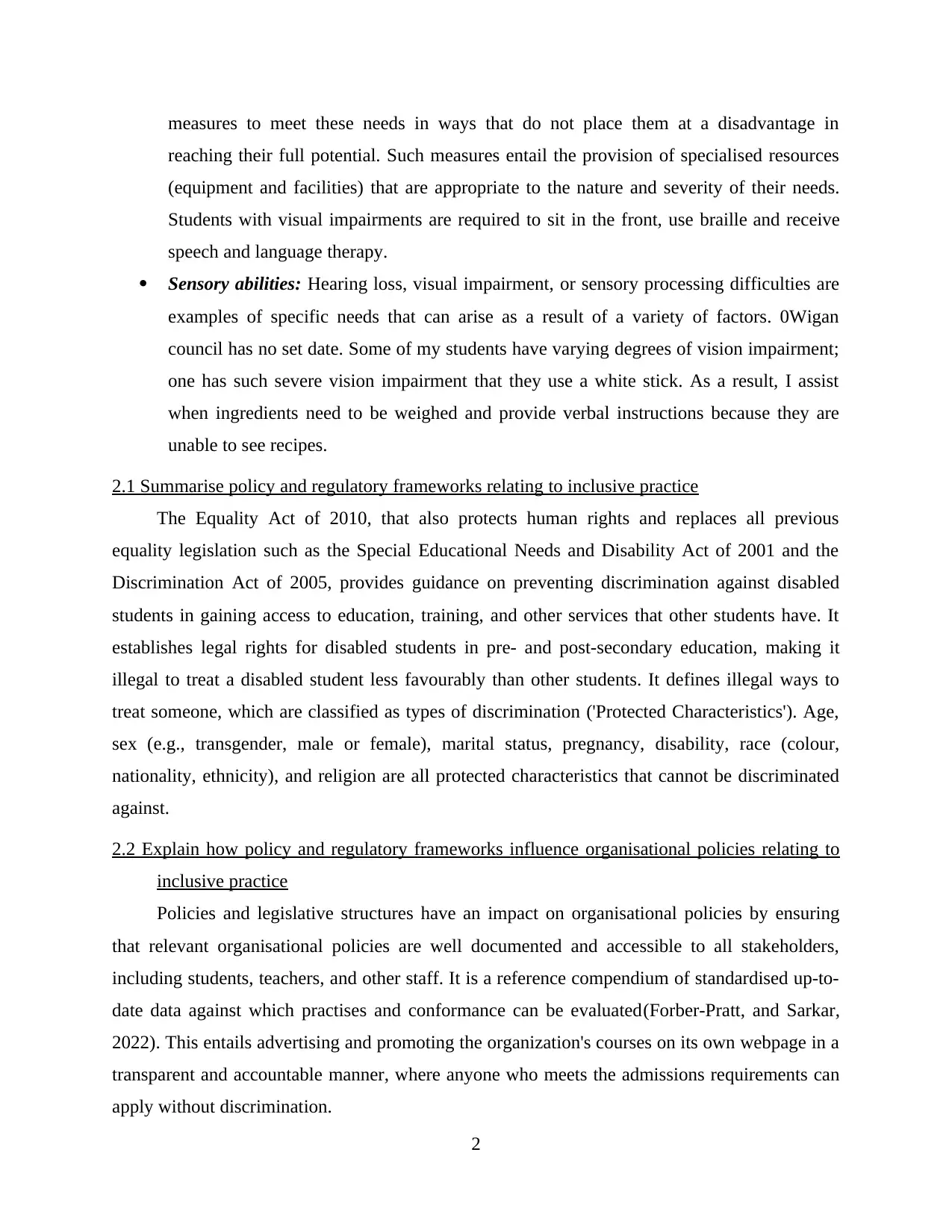
measures to meet these needs in ways that do not place them at a disadvantage in
reaching their full potential. Such measures entail the provision of specialised resources
(equipment and facilities) that are appropriate to the nature and severity of their needs.
Students with visual impairments are required to sit in the front, use braille and receive
speech and language therapy.
Sensory abilities: Hearing loss, visual impairment, or sensory processing difficulties are
examples of specific needs that can arise as a result of a variety of factors. 0Wigan
council has no set date. Some of my students have varying degrees of vision impairment;
one has such severe vision impairment that they use a white stick. As a result, I assist
when ingredients need to be weighed and provide verbal instructions because they are
unable to see recipes.
2.1 Summarise policy and regulatory frameworks relating to inclusive practice
The Equality Act of 2010, that also protects human rights and replaces all previous
equality legislation such as the Special Educational Needs and Disability Act of 2001 and the
Discrimination Act of 2005, provides guidance on preventing discrimination against disabled
students in gaining access to education, training, and other services that other students have. It
establishes legal rights for disabled students in pre- and post-secondary education, making it
illegal to treat a disabled student less favourably than other students. It defines illegal ways to
treat someone, which are classified as types of discrimination ('Protected Characteristics'). Age,
sex (e.g., transgender, male or female), marital status, pregnancy, disability, race (colour,
nationality, ethnicity), and religion are all protected characteristics that cannot be discriminated
against.
2.2 Explain how policy and regulatory frameworks influence organisational policies relating to
inclusive practice
Policies and legislative structures have an impact on organisational policies by ensuring
that relevant organisational policies are well documented and accessible to all stakeholders,
including students, teachers, and other staff. It is a reference compendium of standardised up-to-
date data against which practises and conformance can be evaluated(Forber-Pratt, and Sarkar,
2022). This entails advertising and promoting the organization's courses on its own webpage in a
transparent and accountable manner, where anyone who meets the admissions requirements can
apply without discrimination.
2
reaching their full potential. Such measures entail the provision of specialised resources
(equipment and facilities) that are appropriate to the nature and severity of their needs.
Students with visual impairments are required to sit in the front, use braille and receive
speech and language therapy.
Sensory abilities: Hearing loss, visual impairment, or sensory processing difficulties are
examples of specific needs that can arise as a result of a variety of factors. 0Wigan
council has no set date. Some of my students have varying degrees of vision impairment;
one has such severe vision impairment that they use a white stick. As a result, I assist
when ingredients need to be weighed and provide verbal instructions because they are
unable to see recipes.
2.1 Summarise policy and regulatory frameworks relating to inclusive practice
The Equality Act of 2010, that also protects human rights and replaces all previous
equality legislation such as the Special Educational Needs and Disability Act of 2001 and the
Discrimination Act of 2005, provides guidance on preventing discrimination against disabled
students in gaining access to education, training, and other services that other students have. It
establishes legal rights for disabled students in pre- and post-secondary education, making it
illegal to treat a disabled student less favourably than other students. It defines illegal ways to
treat someone, which are classified as types of discrimination ('Protected Characteristics'). Age,
sex (e.g., transgender, male or female), marital status, pregnancy, disability, race (colour,
nationality, ethnicity), and religion are all protected characteristics that cannot be discriminated
against.
2.2 Explain how policy and regulatory frameworks influence organisational policies relating to
inclusive practice
Policies and legislative structures have an impact on organisational policies by ensuring
that relevant organisational policies are well documented and accessible to all stakeholders,
including students, teachers, and other staff. It is a reference compendium of standardised up-to-
date data against which practises and conformance can be evaluated(Forber-Pratt, and Sarkar,
2022). This entails advertising and promoting the organization's courses on its own webpage in a
transparent and accountable manner, where anyone who meets the admissions requirements can
apply without discrimination.
2
Paraphrase This Document
Need a fresh take? Get an instant paraphrase of this document with our AI Paraphraser
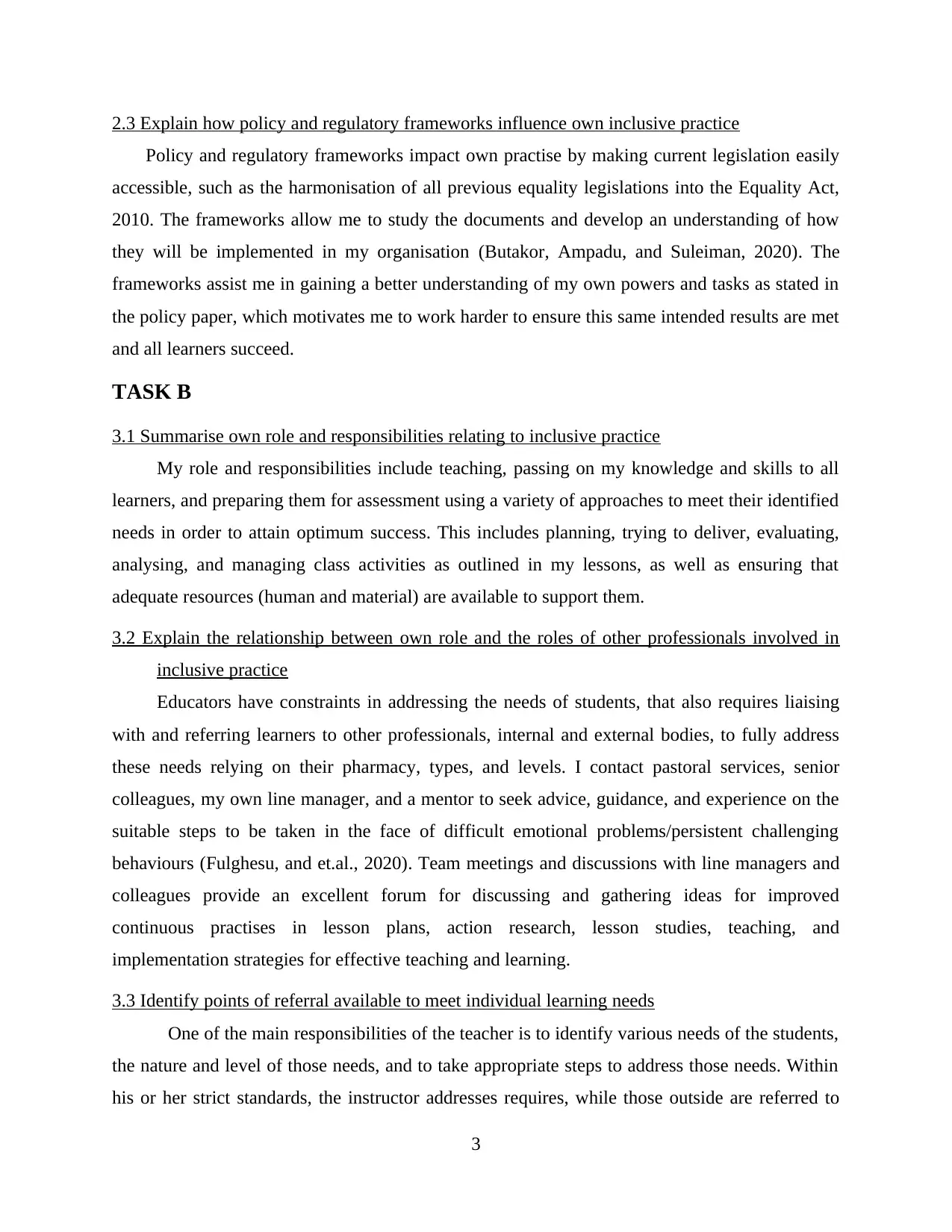
2.3 Explain how policy and regulatory frameworks influence own inclusive practice
Policy and regulatory frameworks impact own practise by making current legislation easily
accessible, such as the harmonisation of all previous equality legislations into the Equality Act,
2010. The frameworks allow me to study the documents and develop an understanding of how
they will be implemented in my organisation (Butakor, Ampadu, and Suleiman, 2020). The
frameworks assist me in gaining a better understanding of my own powers and tasks as stated in
the policy paper, which motivates me to work harder to ensure this same intended results are met
and all learners succeed.
TASK B
3.1 Summarise own role and responsibilities relating to inclusive practice
My role and responsibilities include teaching, passing on my knowledge and skills to all
learners, and preparing them for assessment using a variety of approaches to meet their identified
needs in order to attain optimum success. This includes planning, trying to deliver, evaluating,
analysing, and managing class activities as outlined in my lessons, as well as ensuring that
adequate resources (human and material) are available to support them.
3.2 Explain the relationship between own role and the roles of other professionals involved in
inclusive practice
Educators have constraints in addressing the needs of students, that also requires liaising
with and referring learners to other professionals, internal and external bodies, to fully address
these needs relying on their pharmacy, types, and levels. I contact pastoral services, senior
colleagues, my own line manager, and a mentor to seek advice, guidance, and experience on the
suitable steps to be taken in the face of difficult emotional problems/persistent challenging
behaviours (Fulghesu, and et.al., 2020). Team meetings and discussions with line managers and
colleagues provide an excellent forum for discussing and gathering ideas for improved
continuous practises in lesson plans, action research, lesson studies, teaching, and
implementation strategies for effective teaching and learning.
3.3 Identify points of referral available to meet individual learning needs
One of the main responsibilities of the teacher is to identify various needs of the students,
the nature and level of those needs, and to take appropriate steps to address those needs. Within
his or her strict standards, the instructor addresses requires, while those outside are referred to
3
Policy and regulatory frameworks impact own practise by making current legislation easily
accessible, such as the harmonisation of all previous equality legislations into the Equality Act,
2010. The frameworks allow me to study the documents and develop an understanding of how
they will be implemented in my organisation (Butakor, Ampadu, and Suleiman, 2020). The
frameworks assist me in gaining a better understanding of my own powers and tasks as stated in
the policy paper, which motivates me to work harder to ensure this same intended results are met
and all learners succeed.
TASK B
3.1 Summarise own role and responsibilities relating to inclusive practice
My role and responsibilities include teaching, passing on my knowledge and skills to all
learners, and preparing them for assessment using a variety of approaches to meet their identified
needs in order to attain optimum success. This includes planning, trying to deliver, evaluating,
analysing, and managing class activities as outlined in my lessons, as well as ensuring that
adequate resources (human and material) are available to support them.
3.2 Explain the relationship between own role and the roles of other professionals involved in
inclusive practice
Educators have constraints in addressing the needs of students, that also requires liaising
with and referring learners to other professionals, internal and external bodies, to fully address
these needs relying on their pharmacy, types, and levels. I contact pastoral services, senior
colleagues, my own line manager, and a mentor to seek advice, guidance, and experience on the
suitable steps to be taken in the face of difficult emotional problems/persistent challenging
behaviours (Fulghesu, and et.al., 2020). Team meetings and discussions with line managers and
colleagues provide an excellent forum for discussing and gathering ideas for improved
continuous practises in lesson plans, action research, lesson studies, teaching, and
implementation strategies for effective teaching and learning.
3.3 Identify points of referral available to meet individual learning needs
One of the main responsibilities of the teacher is to identify various needs of the students,
the nature and level of those needs, and to take appropriate steps to address those needs. Within
his or her strict standards, the instructor addresses requires, while those outside are referred to
3
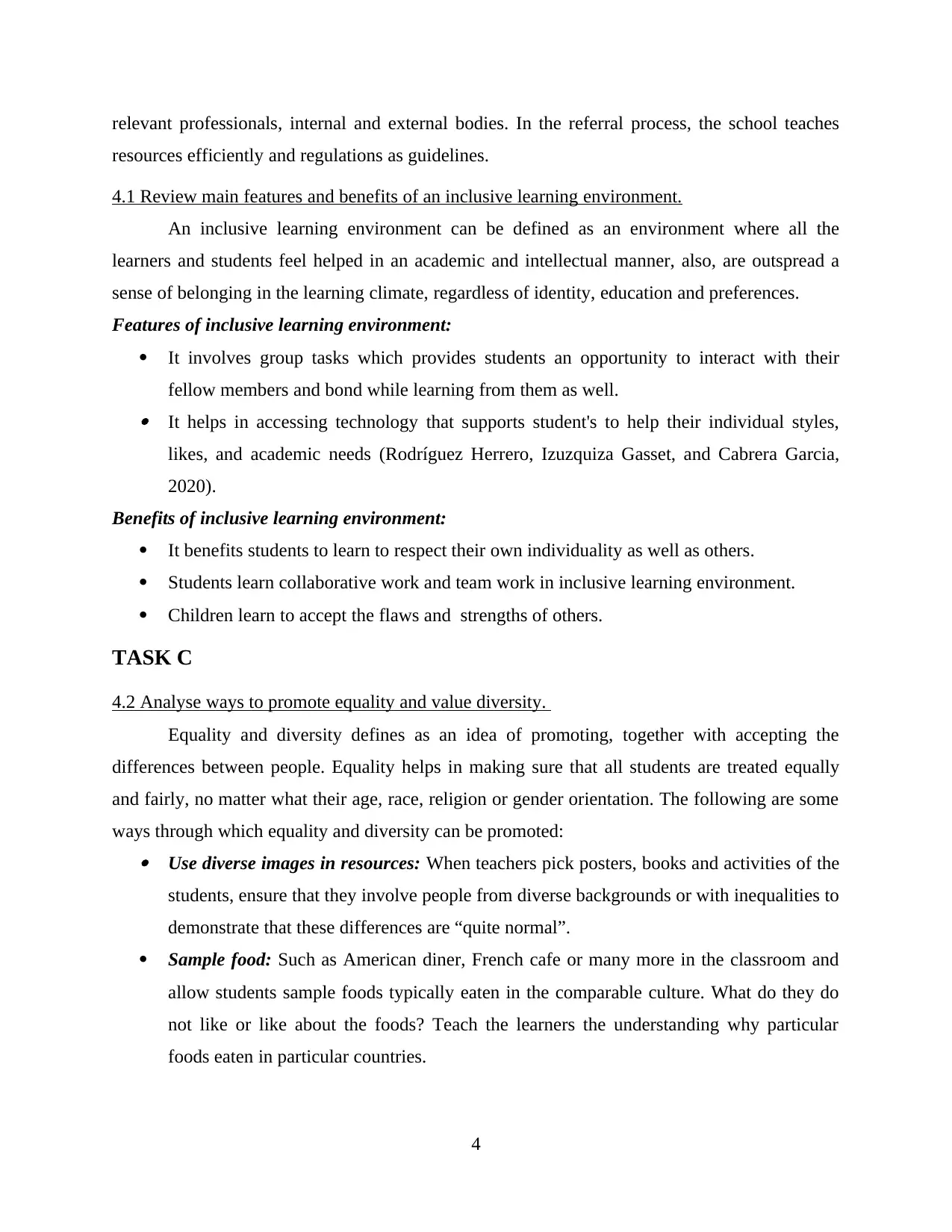
relevant professionals, internal and external bodies. In the referral process, the school teaches
resources efficiently and regulations as guidelines.
4.1 Review main features and benefits of an inclusive learning environment.
An inclusive learning environment can be defined as an environment where all the
learners and students feel helped in an academic and intellectual manner, also, are outspread a
sense of belonging in the learning climate, regardless of identity, education and preferences.
Features of inclusive learning environment:
It involves group tasks which provides students an opportunity to interact with their
fellow members and bond while learning from them as well. It helps in accessing technology that supports student's to help their individual styles,
likes, and academic needs (Rodríguez Herrero, Izuzquiza Gasset, and Cabrera Garcia,
2020).
Benefits of inclusive learning environment:
It benefits students to learn to respect their own individuality as well as others.
Students learn collaborative work and team work in inclusive learning environment.
Children learn to accept the flaws and strengths of others.
TASK C
4.2 Analyse ways to promote equality and value diversity.
Equality and diversity defines as an idea of promoting, together with accepting the
differences between people. Equality helps in making sure that all students are treated equally
and fairly, no matter what their age, race, religion or gender orientation. The following are some
ways through which equality and diversity can be promoted: Use diverse images in resources: When teachers pick posters, books and activities of the
students, ensure that they involve people from diverse backgrounds or with inequalities to
demonstrate that these differences are “quite normal”.
Sample food: Such as American diner, French cafe or many more in the classroom and
allow students sample foods typically eaten in the comparable culture. What do they do
not like or like about the foods? Teach the learners the understanding why particular
foods eaten in particular countries.
4
resources efficiently and regulations as guidelines.
4.1 Review main features and benefits of an inclusive learning environment.
An inclusive learning environment can be defined as an environment where all the
learners and students feel helped in an academic and intellectual manner, also, are outspread a
sense of belonging in the learning climate, regardless of identity, education and preferences.
Features of inclusive learning environment:
It involves group tasks which provides students an opportunity to interact with their
fellow members and bond while learning from them as well. It helps in accessing technology that supports student's to help their individual styles,
likes, and academic needs (Rodríguez Herrero, Izuzquiza Gasset, and Cabrera Garcia,
2020).
Benefits of inclusive learning environment:
It benefits students to learn to respect their own individuality as well as others.
Students learn collaborative work and team work in inclusive learning environment.
Children learn to accept the flaws and strengths of others.
TASK C
4.2 Analyse ways to promote equality and value diversity.
Equality and diversity defines as an idea of promoting, together with accepting the
differences between people. Equality helps in making sure that all students are treated equally
and fairly, no matter what their age, race, religion or gender orientation. The following are some
ways through which equality and diversity can be promoted: Use diverse images in resources: When teachers pick posters, books and activities of the
students, ensure that they involve people from diverse backgrounds or with inequalities to
demonstrate that these differences are “quite normal”.
Sample food: Such as American diner, French cafe or many more in the classroom and
allow students sample foods typically eaten in the comparable culture. What do they do
not like or like about the foods? Teach the learners the understanding why particular
foods eaten in particular countries.
4
⊘ This is a preview!⊘
Do you want full access?
Subscribe today to unlock all pages.

Trusted by 1+ million students worldwide
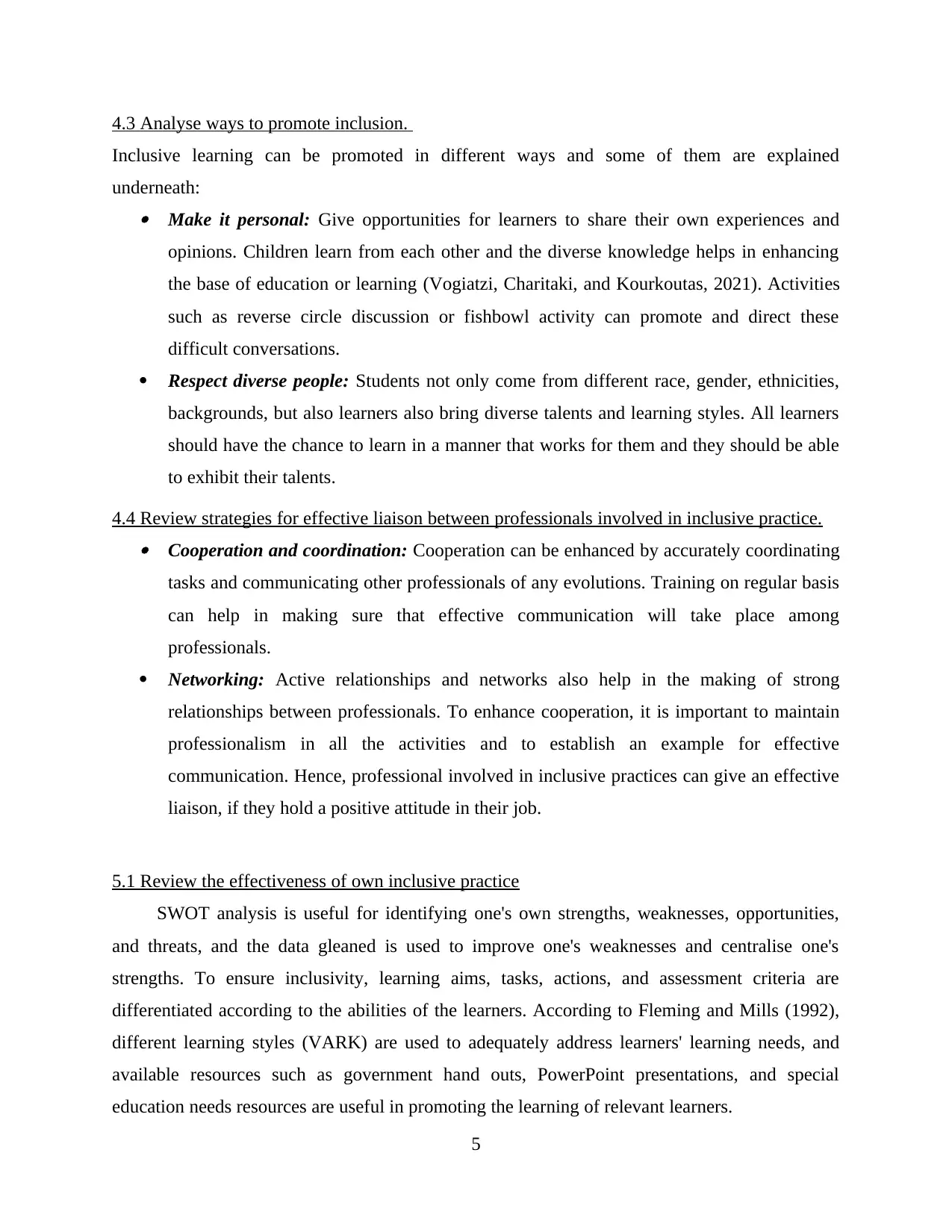
4.3 Analyse ways to promote inclusion.
Inclusive learning can be promoted in different ways and some of them are explained
underneath: Make it personal: Give opportunities for learners to share their own experiences and
opinions. Children learn from each other and the diverse knowledge helps in enhancing
the base of education or learning (Vogiatzi, Charitaki, and Kourkoutas, 2021). Activities
such as reverse circle discussion or fishbowl activity can promote and direct these
difficult conversations.
Respect diverse people: Students not only come from different race, gender, ethnicities,
backgrounds, but also learners also bring diverse talents and learning styles. All learners
should have the chance to learn in a manner that works for them and they should be able
to exhibit their talents.
4.4 Review strategies for effective liaison between professionals involved in inclusive practice. Cooperation and coordination: Cooperation can be enhanced by accurately coordinating
tasks and communicating other professionals of any evolutions. Training on regular basis
can help in making sure that effective communication will take place among
professionals.
Networking: Active relationships and networks also help in the making of strong
relationships between professionals. To enhance cooperation, it is important to maintain
professionalism in all the activities and to establish an example for effective
communication. Hence, professional involved in inclusive practices can give an effective
liaison, if they hold a positive attitude in their job.
5.1 Review the effectiveness of own inclusive practice
SWOT analysis is useful for identifying one's own strengths, weaknesses, opportunities,
and threats, and the data gleaned is used to improve one's weaknesses and centralise one's
strengths. To ensure inclusivity, learning aims, tasks, actions, and assessment criteria are
differentiated according to the abilities of the learners. According to Fleming and Mills (1992),
different learning styles (VARK) are used to adequately address learners' learning needs, and
available resources such as government hand outs, PowerPoint presentations, and special
education needs resources are useful in promoting the learning of relevant learners.
5
Inclusive learning can be promoted in different ways and some of them are explained
underneath: Make it personal: Give opportunities for learners to share their own experiences and
opinions. Children learn from each other and the diverse knowledge helps in enhancing
the base of education or learning (Vogiatzi, Charitaki, and Kourkoutas, 2021). Activities
such as reverse circle discussion or fishbowl activity can promote and direct these
difficult conversations.
Respect diverse people: Students not only come from different race, gender, ethnicities,
backgrounds, but also learners also bring diverse talents and learning styles. All learners
should have the chance to learn in a manner that works for them and they should be able
to exhibit their talents.
4.4 Review strategies for effective liaison between professionals involved in inclusive practice. Cooperation and coordination: Cooperation can be enhanced by accurately coordinating
tasks and communicating other professionals of any evolutions. Training on regular basis
can help in making sure that effective communication will take place among
professionals.
Networking: Active relationships and networks also help in the making of strong
relationships between professionals. To enhance cooperation, it is important to maintain
professionalism in all the activities and to establish an example for effective
communication. Hence, professional involved in inclusive practices can give an effective
liaison, if they hold a positive attitude in their job.
5.1 Review the effectiveness of own inclusive practice
SWOT analysis is useful for identifying one's own strengths, weaknesses, opportunities,
and threats, and the data gleaned is used to improve one's weaknesses and centralise one's
strengths. To ensure inclusivity, learning aims, tasks, actions, and assessment criteria are
differentiated according to the abilities of the learners. According to Fleming and Mills (1992),
different learning styles (VARK) are used to adequately address learners' learning needs, and
available resources such as government hand outs, PowerPoint presentations, and special
education needs resources are useful in promoting the learning of relevant learners.
5
Paraphrase This Document
Need a fresh take? Get an instant paraphrase of this document with our AI Paraphraser
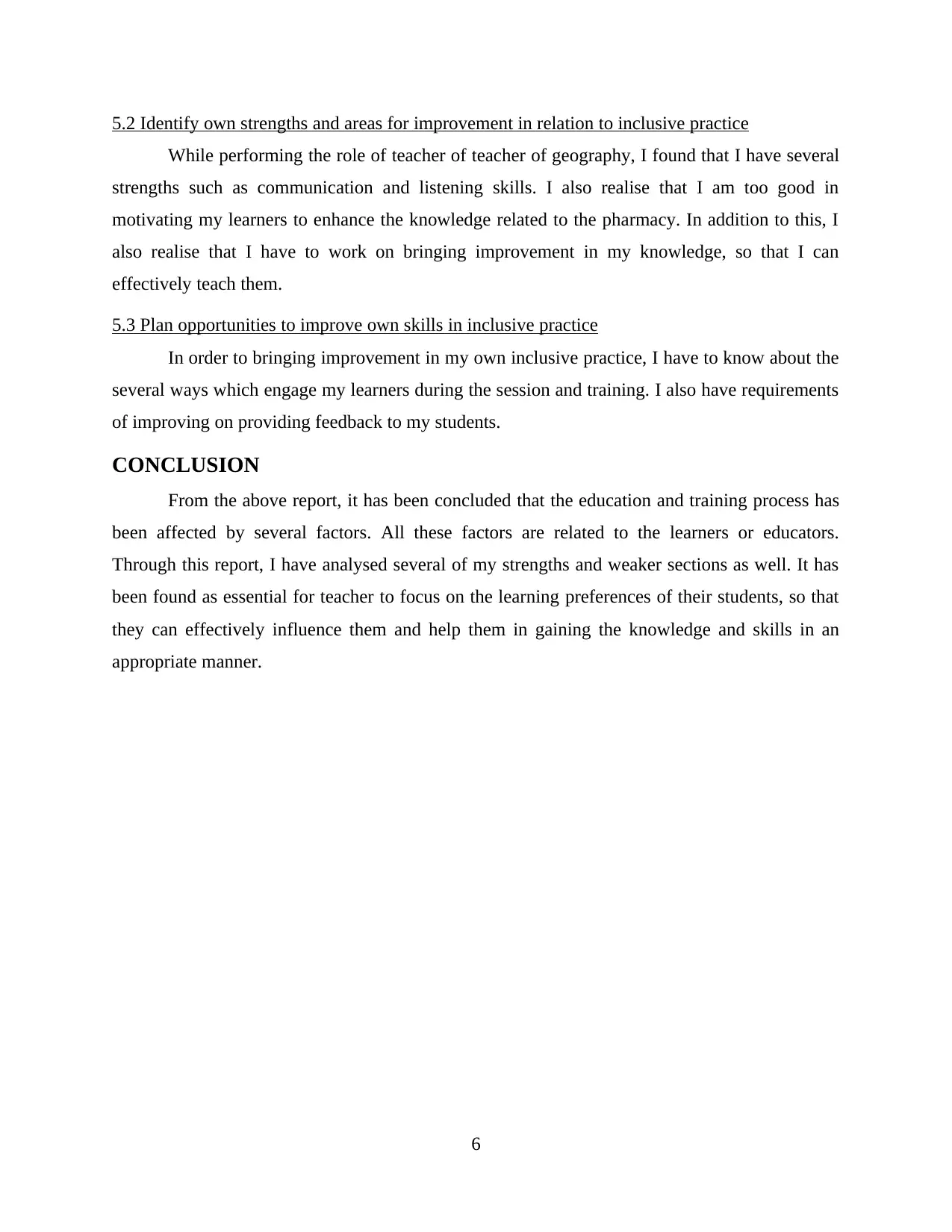
5.2 Identify own strengths and areas for improvement in relation to inclusive practice
While performing the role of teacher of teacher of geography, I found that I have several
strengths such as communication and listening skills. I also realise that I am too good in
motivating my learners to enhance the knowledge related to the pharmacy. In addition to this, I
also realise that I have to work on bringing improvement in my knowledge, so that I can
effectively teach them.
5.3 Plan opportunities to improve own skills in inclusive practice
In order to bringing improvement in my own inclusive practice, I have to know about the
several ways which engage my learners during the session and training. I also have requirements
of improving on providing feedback to my students.
CONCLUSION
From the above report, it has been concluded that the education and training process has
been affected by several factors. All these factors are related to the learners or educators.
Through this report, I have analysed several of my strengths and weaker sections as well. It has
been found as essential for teacher to focus on the learning preferences of their students, so that
they can effectively influence them and help them in gaining the knowledge and skills in an
appropriate manner.
6
While performing the role of teacher of teacher of geography, I found that I have several
strengths such as communication and listening skills. I also realise that I am too good in
motivating my learners to enhance the knowledge related to the pharmacy. In addition to this, I
also realise that I have to work on bringing improvement in my knowledge, so that I can
effectively teach them.
5.3 Plan opportunities to improve own skills in inclusive practice
In order to bringing improvement in my own inclusive practice, I have to know about the
several ways which engage my learners during the session and training. I also have requirements
of improving on providing feedback to my students.
CONCLUSION
From the above report, it has been concluded that the education and training process has
been affected by several factors. All these factors are related to the learners or educators.
Through this report, I have analysed several of my strengths and weaker sections as well. It has
been found as essential for teacher to focus on the learning preferences of their students, so that
they can effectively influence them and help them in gaining the knowledge and skills in an
appropriate manner.
6
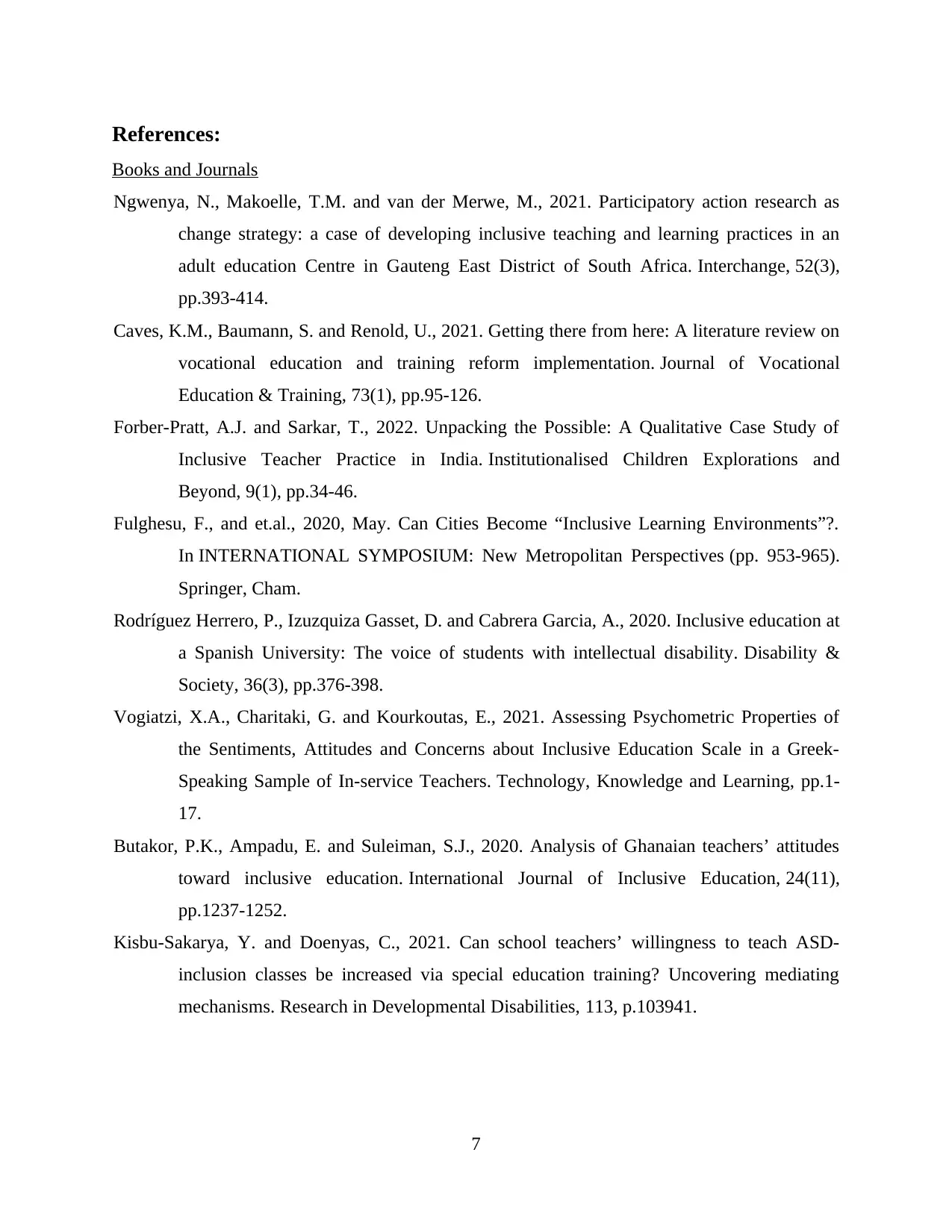
References:
Books and Journals
Ngwenya, N., Makoelle, T.M. and van der Merwe, M., 2021. Participatory action research as
change strategy: a case of developing inclusive teaching and learning practices in an
adult education Centre in Gauteng East District of South Africa. Interchange, 52(3),
pp.393-414.
Caves, K.M., Baumann, S. and Renold, U., 2021. Getting there from here: A literature review on
vocational education and training reform implementation. Journal of Vocational
Education & Training, 73(1), pp.95-126.
Forber-Pratt, A.J. and Sarkar, T., 2022. Unpacking the Possible: A Qualitative Case Study of
Inclusive Teacher Practice in India. Institutionalised Children Explorations and
Beyond, 9(1), pp.34-46.
Fulghesu, F., and et.al., 2020, May. Can Cities Become “Inclusive Learning Environments”?.
In INTERNATIONAL SYMPOSIUM: New Metropolitan Perspectives (pp. 953-965).
Springer, Cham.
Rodríguez Herrero, P., Izuzquiza Gasset, D. and Cabrera Garcia, A., 2020. Inclusive education at
a Spanish University: The voice of students with intellectual disability. Disability &
Society, 36(3), pp.376-398.
Vogiatzi, X.A., Charitaki, G. and Kourkoutas, E., 2021. Assessing Psychometric Properties of
the Sentiments, Attitudes and Concerns about Inclusive Education Scale in a Greek-
Speaking Sample of In-service Teachers. Technology, Knowledge and Learning, pp.1-
17.
Butakor, P.K., Ampadu, E. and Suleiman, S.J., 2020. Analysis of Ghanaian teachers’ attitudes
toward inclusive education. International Journal of Inclusive Education, 24(11),
pp.1237-1252.
Kisbu-Sakarya, Y. and Doenyas, C., 2021. Can school teachers’ willingness to teach ASD-
inclusion classes be increased via special education training? Uncovering mediating
mechanisms. Research in Developmental Disabilities, 113, p.103941.
7
Books and Journals
Ngwenya, N., Makoelle, T.M. and van der Merwe, M., 2021. Participatory action research as
change strategy: a case of developing inclusive teaching and learning practices in an
adult education Centre in Gauteng East District of South Africa. Interchange, 52(3),
pp.393-414.
Caves, K.M., Baumann, S. and Renold, U., 2021. Getting there from here: A literature review on
vocational education and training reform implementation. Journal of Vocational
Education & Training, 73(1), pp.95-126.
Forber-Pratt, A.J. and Sarkar, T., 2022. Unpacking the Possible: A Qualitative Case Study of
Inclusive Teacher Practice in India. Institutionalised Children Explorations and
Beyond, 9(1), pp.34-46.
Fulghesu, F., and et.al., 2020, May. Can Cities Become “Inclusive Learning Environments”?.
In INTERNATIONAL SYMPOSIUM: New Metropolitan Perspectives (pp. 953-965).
Springer, Cham.
Rodríguez Herrero, P., Izuzquiza Gasset, D. and Cabrera Garcia, A., 2020. Inclusive education at
a Spanish University: The voice of students with intellectual disability. Disability &
Society, 36(3), pp.376-398.
Vogiatzi, X.A., Charitaki, G. and Kourkoutas, E., 2021. Assessing Psychometric Properties of
the Sentiments, Attitudes and Concerns about Inclusive Education Scale in a Greek-
Speaking Sample of In-service Teachers. Technology, Knowledge and Learning, pp.1-
17.
Butakor, P.K., Ampadu, E. and Suleiman, S.J., 2020. Analysis of Ghanaian teachers’ attitudes
toward inclusive education. International Journal of Inclusive Education, 24(11),
pp.1237-1252.
Kisbu-Sakarya, Y. and Doenyas, C., 2021. Can school teachers’ willingness to teach ASD-
inclusion classes be increased via special education training? Uncovering mediating
mechanisms. Research in Developmental Disabilities, 113, p.103941.
7
⊘ This is a preview!⊘
Do you want full access?
Subscribe today to unlock all pages.

Trusted by 1+ million students worldwide
1 out of 9
Related Documents
Your All-in-One AI-Powered Toolkit for Academic Success.
+13062052269
info@desklib.com
Available 24*7 on WhatsApp / Email
![[object Object]](/_next/static/media/star-bottom.7253800d.svg)
Unlock your academic potential
Copyright © 2020–2025 A2Z Services. All Rights Reserved. Developed and managed by ZUCOL.




